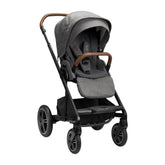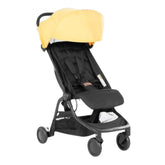Vertex Position: Why It's Important & How to Get Baby There

During pregnancy, your doctor might talk about how your baby is positioned inside you. As your due date gets closer, they'll mention the "presentation" or position of the baby lower in your belly. Basically, they're talking about which part of your baby will come out first. If they say your baby's head is down or in the vertex position, that's usually a good sign. It means your baby is ready to come out head-first, which is the most common way babies are positioned in the last part of pregnancy. Let’s take a closer look at what is vertex position, why it’s important, and a few ways to encourage your baby to turn into the right position before you go into labor.
What Is Vertex Position in Pregnancy?
Vertex is a type of cephalic, or head-down, position. There are other types of cephalic presentations, such as brow and face. These mainly describe how the fetus’s neck is flexed. The vertex position specifically refers to the baby's chin being tucked into its chest facing mom’s spine so that the back of the head comes out first. It's the most common and natural way for a baby to be positioned for birth.
Why Is Vertex Position of the Fetus Important?
When it's time for labor and delivery, the best position for a baby to be in is the vertex position. This is especially true if the back of the baby's head (occiput) is facing toward the front of the pregnant person's pelvis. This position makes vaginal birth easier, quicker, and less painful. The baby's head fits well through the birth canal in this position. On the other hand, if the back of the baby's head is toward the pregnant person's spine, it's called the occiput posterior position. This can lead to longer labor and more discomfort during birth.
There are other positions that aren't as good for labor and delivery as well. They can make labor take longer, cause problems for the baby, and sometimes require interventions like vacuum or forceps assistance, or even a Cesarean delivery. Another thing to know is that positions other than vertex increase the risk of the umbilical cord falling into the vaginal canal before the baby, which is called cord prolapse. For example, if the baby is sideways and the water breaks, there's a higher chance of the cord coming out before the baby.
When doctors are helping with your baby's delivery, they check which part of the baby is in position to come out first. If the baby's head is down during labor, they'll check if the back of the head is facing the front or back of the pregnant person and if the back of the head is presenting or if it's the face or brow. These details matter, especially if they're considering using a vacuum or forceps to assist with the delivery.

When Does Vertex Fetal Position Typically Happen?
Doctors start checking how the baby is positioned in your belly around 32 to 34 weeks of pregnancy. By 30 weeks, about 75% to 80% of babies have their heads down, and by 37 weeks, it's around 96% to 97%. Only about 3% to 4% of babies are in a different position when it's time to give birth. To figure this out, doctors use a technique called Leopold maneuvers. They put their hands on your belly in different places to find where the baby's head and bottom are.
If your baby's head isn't down, the next common position is called breech. That's when the baby's legs or bottom are down, and the head is up near your ribs. Sometimes, the baby might be lying sideways, which is called transverse. This means the baby is lying across your belly, not up and down. There's also a chance the baby might be diagonal, called oblique. In this position, either the head or the bottom might be down, but they're not in the middle of your belly. If the baby's head isn't down, the doctor will check if the bottom is down or if the baby's feet are down. If the baby is lying sideways, the doctor will also check if the baby's back is facing down or up since this is especially important if you might need a Cesarean delivery.
Restore radiance to your skin with the Mama Mio Tummy Rub Butter. The soothing formula is lightweight, creamy, and glides across the skin effortlessly, with a little product covering most of your baby bump. Created to heighten the appearance of tauter, smoother skin with added elasticity during pregnancy, the innovative components within the tummy butter work to reduce the look of stretch marks.

What Are Some Ways to Get My Baby in the Vertex Position?
There are a number of ways to help turn a breech baby. To help your baby get into the vertex position (head down), stay active and go for walks. Gravity can be your friend here, as it might help the baby's head move to the lowest spot. If your baby isn't in the head-down position and you're getting close to your due date, there are a few other things you can try.
One method involves getting on all fours for about 10 minutes each day. This position, where your head is down and your buttocks are up, can help turn the baby around 60% to 70% of the time. Another option is seeing a chiropractor who uses the Webster technique to encourage the baby to turn head-first.

There are also some home remedies you could experiment with, even though they don't have strong scientific backing. Things like using music, heat, ice, or incense near your belly might encourage the baby to move. You can also do the pelvic tilt: lie on your back with bent legs, your feet on the ground, and lift your pelvis like a bridge for 10 minutes a few times a day, especially when your baby is active.
Some women have tried putting headphones low on their belly to encourage the baby to move toward the sound. You could also place a cold bag of veggies near the top of your uterus and something warm at the lower part to get the baby to turn. Acupuncture has also been used to help babies get into the right position. While not backed by a lot of science, these methods are generally safe to try.
What Happens If Baby Is Not in the Vertex Position?
If you're almost due and your baby isn't positioned head-first (vertex position) or in some other head-down position, you might want to talk about something called an external cephalic version (ECV). This happens in the hospital, and your doctor will try to gently turn the baby manually to get it into the right position. That said, not everyone is a candidate for this procedure, and it does come with some risks, so talk to your doctor about it.
If all attempts to turn the baby don't work and it stays in a non-head-down position, most doctors will suggest a C-section for delivery. It's important to know that having a baby in a breech position (bottom or feet first) during a vaginal delivery has more risks for the baby. The American College of Obstetricians and Gynecologists recommends a C-section in this case. Once labor starts, it's too late for the baby to change its position.
The Takeaway on Getting Baby to the Vertex Position
If your baby isn't in the right head-down position yet, don't stress. Most babies naturally turn their heads or bottoms to the right spot before they're born. While you wait, take care of yourself by staying active and resting well. If you're worried, talk to your doctor about ways to encourage your baby to move into the right position. They can give you advice that fits your situation.
Disclaimer: The information on our site is NOT medical advice for any specific person or condition. It is only meant as general information. Please contact your health provider if you have any medical questions or concerns about your child or yourself.









